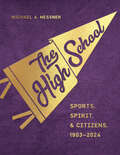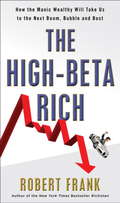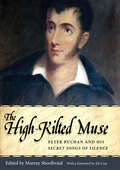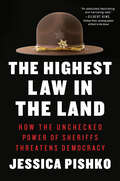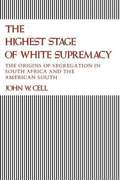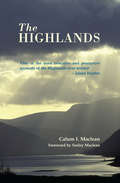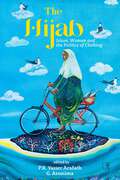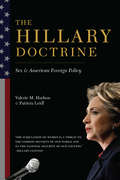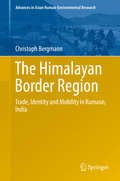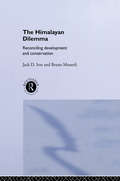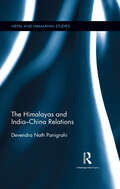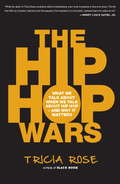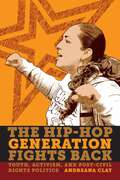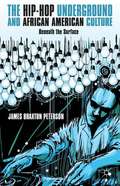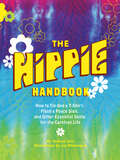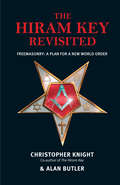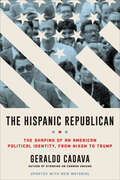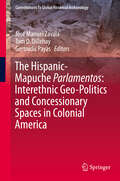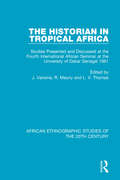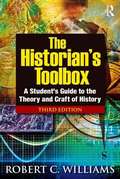- Table View
- List View
The High School: Sports, Spirit, and Citizens, 1903-2024 (Critical Issues in Sport and Society)
by Michael A. MessnerHigh school yearbooks provide both a vivid snapshot of student life and a reflection of what the adults in the community valued the most. For instance, athletics are often covered more than academics, and boys’ sports routinely receive more attention than girls’ sports. But how have those values changed over time? In The High School, acclaimed sociologist Michael A. Messner reads through 120 years of El Gabilan, the yearbook from his own alma mater, Salinas High School in California, where his father taught and coached. Treating the yearbooks as a historical archive, Messner makes surprising discoveries about the school he thought he knew so well. For example, over fifty years before Title IX, the earliest yearbooks gave equal spotlights to boys’ and girls’ athletics, while the cheerleaders were all boys. Tracing American life and culture from 1903 to 2024, Messner illuminates shifts in social practices at his high school that reflect broader changes in American culture across the twentieth century. The High School spotlights how the meanings and iconography of certain activities have changed radically over the decades, even as the “sports spirit complex”—involving athletes, cheerleaders, band members, and community boosters—has remained a central part of the high school experience. By exploring evolving sports cultures, socioeconomic conditions, racial demographics, and gender norms, Messner offers a fresh perspective on a defining feature of American teenage life.
The High-Beta Rich
by Robert Frankhigh-beta rich (hi be'ta rich) 1. a newly discovered personality type of the America upper class prone to wild swings in wealth. 2. the winners (and occasional losers) in an economy that creates wealth from financial markets, asset bubbles and deals. 3. derived from the Wall Street term "high-beta," meaning highly volatile or prone to booms and busts. 4. an elite that's capable of wreaking havoc on communities, jobs, government finances, and the consumer economy. 5. a new Potemkin plutocracy that hides a mountain of debt behind the image of success, and is one crisis away from losing their mansions, private jets and yachts.The rich are not only getting richer, they are becoming more dangerous. Starting in the early 1980s the top one percent broke away from the rest of us to become the most unstable force in the economy. An elite that had once been the flat line on the American income charts - models of financial propriety - suddenly set off on a wild ride of economic binges. Not only do they control more than a third of the country's wealth, their increasing vulnerability to the booms and busts of the stock market wreak havoc on our consumer economy, financial markets, communities, employment opportunities, and government finances. Robert Frank's insightful analysis provides the disturbing big picture of high-beta wealth. His vivid storytelling brings you inside the mortgaged mansions, blown-up balance sheets, repossessed Bentleys and Gulfstreams, and wrecked lives and relationships:* How one couple frittered away a fortune trying to build America's biggest house --90,000 square feet with 23 full bathrooms, a 6,000 square foot master suite with a bed on a rotating platform--only to be forced to put it on the market because "we really need the money". * Repo men who are now the scavengers of the wealthy, picking up private jets, helicopters, yachts and racehorses - the shiny remains of a decade of conspicuous consumption financed with debt, asset bubbles, "liquidity events," and soaring stock prices. * How "big money ruins everything" for communities such as Aspen, Colorado whose over-reliance on the rich created a stratified social scene of velvet ropes and A-lists and crises in employment opportunities, housing, and tax revenues. * Why California's worst budget crisis in history is due in large part to reliance on the volatile incomes of the state's tech tycoons. * The bitter divorce of a couple who just a few years ago made the Forbes 400 list of the richest people, the firing of their enormous household staff of 110, and how one former spouse learned the marvels of shopping at Marshalls, filling your own gas tank, and flying commercial. Robert Frank's stories and analysis brilliantly show that the emergence of the high-beta rich is not just a high-class problem for the rich. High-beta wealth has national consequences: America's dependence on the rich + great volatility among the rich = a more volatile America. Cycles of wealth are now much faster and more extreme. The rich are a new "Potemkin Plutocracy" and the important lessons and consequences are brought to light of day in this engrossing book.From the Hardcover edition.
The High-Kilted Muse: Peter Buchan and His Secret Songs of Silence
by Murray ShoolbraidIn 1832 the Scottish ballad collector Peter Buchan of Peterhead, Aberdeenshire, presented an anthology of risqué‚ and convivial songs and ballads to a Highland laird. When Professor Francis James Child of Harvard was preparing his magisterial edition of The English and Scottish Popular Ballads, he made inquiries about it, but it was not made available in time to be considered for his work. On his death it was presented to the Child Memorial Library at Harvard. Because of its unseemly materials, the manuscript languished there since, unprinted, though referred to now and again, and a few items from time to time made an appearance. The manuscript has now been transcribed with full annotation and with an introduction on the compiler, his times, and the Scottish bawdy tradition. It contains the texts (without tunes) of seventy-six bawdy songs and ballads, along with a long-lost scatological poem attributed to the Edinburgh writer James “Balloon” Tytler. Appendices give details of Buchan's two published collections of ballads. Additionally, there is a list of tale types and motifs, a glossary of Scots and archaic words, a bibliography, and an index. The High-Kilted Muse brings to light a long-suppressed volume and fills in a great gap in published bawdy songs and ballads.
The Highest Glass Ceiling: Women's Quest for the American Presidency
by Ellen FitzpatrickBest-selling historian Ellen Fitzpatrick tells the story of three remarkable women who set their sights on the Presidency. The arduous, dramatic quests of Victoria Woodhull (1872), Margaret Chase Smith (1964), and Shirley Chisholm (1972) illuminate today's political landscape, shedding light on Hillary Clinton's 2016 campaign for the Oval Office.
The Highest Law in the Land: How the Unchecked Power of Sheriffs Threatens Democracy
by Jessica PishkoShortlisted for Columbia Journalism School&’s J. Anthony Lukas PrizeA Publishers Lunch NonFiction Buzz Book| Named Most Anticipated by Los Angeles Times A leading authority on sheriffs investigates the impunity with which they police their communities, alongside the troubling role they play in American life, law enforcement, and, increasingly, national politics. The figure of the American sheriff has loomed large in popular imagination, though given the outsize jurisdiction sheriffs have over people&’s lives, the office of sheriffs remains a gravely under-examined institution. Locally elected, largely unaccountable, and difficult to remove, the country&’s over three thousand sheriffs, mostly white men, wield immense power—making arrests, running county jails, enforcing evictions and immigration laws—with a quarter of all U.S. law enforcement officers reporting to them. In recent years there&’s been a revival of &“constitutional sheriffs,&” who assert that their authority supersedes that of legislatures, courts, and even the president. They&’ve protested federal mask and vaccine mandates and gun regulations, railed against police reforms, and, ultimately, declared themselves election police, with many endorsing the &“Big Lie&” of a stolen presidential election. They are embraced by far-right militia groups, white nationalists, the Claremont Institute, and former president Donald Trump, who sees them as allies in mass deportation and border policing. How did a group of law enforcement officers decide that they were &“above the law?&” What are the stakes for local and national politics, and for America as a multi-racial democracy? Blending investigative reporting, historical research, and political analysis, author Jessica Pishko takes us to the roots of why sheriffs have become a flashpoint in the current politics of toxic masculinity, guns, white supremacy, and rural resentment, and uncovers how sheriffs have effectively evaded accountability since the nation&’s founding. A must-read for fans of Michelle Alexander, Gilbert King, Elizabeth Hinton, and Kathleen Belew.
The Highest Stage of White Supremacy: The Origins of Segregation in South Africa and the American South
by John W. CellThis book analyses the origins of segregation in South Africa and the American South.
The Highlands
by Calum MacleanIn a new edition of this classic book, introduced by the world-renowned Gaelic poet Sorley Maclean, the late Calum I. Maclean, a Gaelic-speaking Highlander, interprets the traditional background, culture and ways of life of his native country. Calum's formal training in folk culture and the depth of his local knowledge make this book truly outstanding - it is written by a Highlander from the inside. Many books on the Highlands have been penned by outsiders with an uncritical appreciation of the scenery and only the most superficial knowledge of the Gaelic language and culture. By contrast, Maclean brought informed attitudes and sympathetic opinions. He was concerned not so much with places, beauty spots and scenery as with the Highlanders in their own self-created environment. He writes in terms of individuals and suggests reasons why Highland culture is unique in the world - it is something that, if lost, can never be recovered or recreated.
The Hijab: Islam, Women and the Politics of Clothing
by PK Yasser Arafath G ArunimaHistorically, in India, we have instances of both unveiling and veiling that have been initiated by Indian Muslim women. The early 20th century saw many Muslim women joining the national movement, giving up veiling, feeling this was the only way for them to change their own, and the country's, future. Almost a hundred years later, the hijab continues to be a bone of contention in India, though in very different ways. On one hand, the rape threats that hijabi/non-hijabi women frequently encounter in the cyber world reflect the extreme desperation of the aggravated Hindutva millennials who are made to believe that unveiling Muslim women is their right while a large segment of Indian Muslim women are increasingly convinced that wearing the hijab is their constitutional prerogative. This collection of essays, primarily from India but also with a couple from Bangladesh and Iran, complicates the relationship between Muslim women and the hijab. Moving away from predictable interpretations that see the hijab merely as an instrument of Muslim women&’s oppression, the essays here, from a variety of perspectives including historical, ethnographic, and political, demonstrate that not only have Muslim women covered/ or uncovered their heads for different reasons, but the head cloth itself has had different forms depending on the region or period of history. The essays track the reasons why clothing, especially women&’s attire, is very often a site of contestation and provide ways to hear and understand the ways in which Muslim girls or women make their own sartorial choices. They also offer ways of interpreting the stakes in banning the hijab in different parts of the world, and the implications of the ban on Muslim women, the wider community and the very idea of citizenship itself.
The Hillary Doctrine
by Swanee Hunt Valerie M. Hudson Patricia LeidlHillary Rodham Clinton is the first Secretary of State to declare the subjugation of women worldwide a serious threat to U.S. national security. Known as the Hillary Doctrine, her stance was made part of the 2010 Quadrennial Diplomatic and Development Review of U.S. foreign policy, formally committing America to the proposition that the empowerment of women is a stabilizing force for domestic and international peace.Blending history, fieldwork, theory, and policy analysis while incorporating perspectives from officials and activists on the front lines of implementation, this is the first book to thoroughly investigate the Hillary Doctrine in principle and practice. Does the insecurity of women make nations less secure? How has the doctrine changed the foreign policy of the United States and altered its relationship with other countries, such as China and Mexico? With specific studies of Guatemala, Afghanistan, Saudi Arabia, and Yemen, this invaluable policy text closes the gap between rhetoric and reality, confronting head-on what the future of fighting such an entrenched enemy entails. It reports directly on the work being done by U.S. government agencies, including the Office of Global Women's Issues, established by Clinton during her tenure at the State Department, and explores the complexity and pitfalls of attempting to improve the lives of women while safeguarding the national interest.
The Hillary Doctrine: Sex and American Foreign Policy
by Patricia Leidl Valerie HudsonHillary Rodham Clinton was the first Secretary of State to declare the subjugation of women worldwide a serious threat to U.S. national security. Known as the Hillary Doctrine, her stance was the impetus behind the 2010 Quadrennial Diplomatic and Development Review of U.S. foreign policy, formally committing America to the proposition that the empowerment of women is a stabilizing force for domestic and international peace.Blending history, fieldwork, theory, and policy analysis while incorporating perspectives from officials and activists on the front lines of implementation, this book is the first to thoroughly investigate the Hillary Doctrine in principle and practice. Does the insecurity of women make nations less secure? How has the doctrine changed the foreign policy of the United States and altered its relationship with other countries such as China and Saudi Arabia? With studies focusing on Guatemala, Afghanistan, and Yemen, this invaluable policy text closes the gap between rhetoric and reality, confronting head-on what the future of fighting such an entrenched enemy entails. The research reports directly on the work being done by U.S. government agencies, including the Office of Global Women's Issues, established by Clinton during her tenure at the State Department, and explores the complexity and pitfalls of attempting to improve the lives of women while safeguarding the national interest.
The Himalayan Border Region
by Christoph BergmannDrawing fromextensive archival work and long-term ethnographic research, this book focuseson the so-called Bhotiyas, former trans-Himalayan traders and a Scheduled Tribeof India who reside in several high valleys of the Kumaon Himalaya. The area islocated in the border triangle between India, the Tibet Autonomous Region (TAR,People's Republic of China), and Nepal, where contestations over politicalboundaries have created multiple challenges as well as opportunities for localmountain communities. Basedon an analytical framework that is grounded in and contributes to recentadvances in the field of border studies, the author explores how theBhotiyas have used their agency to developa flourishing trans-Himalayan trade under British colonial influence; to assertan identity and win legal recognition as a tribal community in the politicalsetup of independent India; and to innovate their pastoral mobility in thecontext of ongoing state and market reforms. By examining theBhotiyas' trade, identity and mobility thisbook shows how and why the Himalayan border region has evolved as an agentive siteof political action for a variety of different actors.
The Himalayan Dilemma: Reconciling Development and Conservation
by Jack D. Ives Bruno Messerli`This is an important book that deserves to be read by everyone concerned with presenting major environmental issues.' Geography` ... an essential text for policy makers and aid professionals, as well as for students of environmental studies and international development ... It is indeed, a book appropriate to the urgent and critical issues which it addresses.' - Journal of Environmental Management
The Himalayas and India-China Relations (Nepal and Himalayan Studies)
by Devendra Nath PanigrahiThis book provides a systematic analysis of China's rise to power. It traces the complex contours of its relation with India, with the Himalayas prominently figuring in the discourse. Drawing on myths, legends, classical literature, archival resources and contemporary political and international affairs, it brings to the fore several critical issues integral to India–China relations. It also studies the two nations in terms of trade across borders, exchange of ideas and confluence of diverse cultures, imperial strategic rivalries in the colonial period, and recent military skirmishes and diplomatic interaction. Lucid and explanatory, this volume will interest scholars and researchers in international relations, history, political science and area studies specially those interested in the geopolitics of India and China.
The Hindu Family and the Emergence of Modern India
by Eleanor NewbiginBetween 1955 and 1956 the Government of India passed four Hindu Law Acts to reform and codify Hindu family law. Scholars have understood these acts as a response to growing concern about women's rights but, in a powerful re-reading of their history, this book traces the origins of the Hindu law reform project to changes in the political-economy of late colonial rule. The Hindu Family and the Emergence of Modern India considers how questions regarding family structure, property rights and gender relations contributed to the development of representative politics, and how in solving these questions, India's secular and state power structures were consequently drawn into a complex and unique relationship with Hindu law. In this comprehensive and illuminating resource for scholars and students, Newbigin demonstrates the significance of gender and economy to the history of twentieth-century democratic government, as it emerged in India, and beyond.
The Hip Hop Wars: What We Talk About When We Talk About Hip Hop--and Why It Matters
by Tricia RoseHip-hop is in crisis. For the past dozen years, the most commercially successful hip-hop has become increasingly saturated with caricatures of black gangstas, thugs, pimps, and 'hos. The controversy surrounding hip-hop is worth attending to and examining with a critical eye because, as scholar and cultural critic Tricia Rose argues, hip-hop has become a primary means by which we talk about race in the United States.In The Hip-Hop Wars, Rose explores the most crucial issues underlying the polarized claims on each side of the debate: Does hip-hop cause violence, or merely reflect a violent ghetto culture? Is hip-hop sexist, or are its detractors simply anti-sex? Does the portrayal of black culture in hip-hop undermine black advancement?A potent exploration of a divisive and important subject, The Hip-Hop Wars concludes with a call for the regalvanization of the progressive and creative heart of hip-hop. What Rose calls for is not a sanitized vision of the form, but one that more accurately reflects a much richer space of culture, politics, anger, and yes, sex, than the current ubiquitous images in sound and video currently provide.
The Hip-Hop Generation Fights Back: Youth, Activism and Post-Civil Rights Politics
by Andreana ClayFrom youth violence, to the impact of high stakes educational testing, to editorial hand wringing over the moral failures ofhip-hop culture, young people of color are often portrayed as gang affiliated, “troubled,” and ultimately, dangerous. The Hip-Hop Generation Fights Back examines how youth activism has emerged to address the persistent inequalities that affect urban youth of color. Andreana Clay provides a detailed account of the strategies that youth activists use to frame their social justice agendas and organize in their local communities.Based on two years of fieldwork with youth affiliated with two non-profit organizations in Oakland, California, The Hip-Hop Generation Fights Back shows how youth integrate the history of social movement activism of the 1960s, popular culture strategies like hip-hop and spoken word, as well as their experiences in the contemporary urban landscape, to mobilize their peers. Ultimately, Clay’s comparison of the two youth organizations and their participants expands our understandings of youth culture, social movements, popular culture, and race and ethnic relations.
The Hip-Hop Generation: Young Blacks and the Crisis in African-American Culture
by KitwanaThe Hip Hop Generation is an eloquent testament for black youth culture at the turn of the century. The only in-depth study of the first generation to grow up in post-segregation America, it combines culture and politics into a pivotal work in American studies. Bakari Kitwana, one of black America's sharpest young critics, offers a sobering look at this generation's disproportionate social and political troubles, and celebrates the activism and politics that may herald the beginning of a new phase of African-American empowerment.
The Hip-hop Underground And African American Culture
by James Braxton PetersonThe underground is a multi-faceted concept in African American culture. Peterson uses Richard Wright, KRS-One, Thelonius Monk, and the tradition of the Underground Railroad to explore the manifestations and the attributes of the underground within the context of a more panoramic picture of African American expressivity within hip-hop.
The Hippie Handbook: How to Tie-Dye a T-Shirt, Flash a Peace Sign, and Other Essential Skills for the Carefree Life
by Chelsea CainA groovy guide to hippie culture from the New York Times–bestselling author.Brothers and sisters! Here at last is a light-hearted, free-spirited, groovy guide to the timeless hippie skills and activities that make the world a better place, one macrame belt at a time. In illustrated, easy-to-follow instructions, author Chelsea Cain—who grew up on an Iowa hippie commune—provides practical and playful know-how for the hippie and hippie-at-heart. Learn how to milk a goat, build a compost pile, play “Kumbaya” on the guitar, teach a dog how to catch a Frisbee, and get your file from the FBI. Discover the finer points of caring for a fern, choosing a mantra, organizing a protest, naming your hippie baby, and making sand candles as holiday gifts. Including primers on cooking, dressing, driving, telling time, dancing, and celebrating your birthday in classic hippie style, and a righteous appendix of essential hippie books, movies, and slang, The Hippie Handbook knows the score. Right on.“Run us cheerily through the basics of the hippie lifestyle and beyond.” —January Magazine
The Hiram Key Revisited: Freemasonry: A Plan For a New World Order
by Alan Butler Christopher KnightA comprehensive and compelling account of the secret society that has shaped world events—and its ongoing influence today.Freemasonry, with its arcane rituals, occult symbols, and labyrinthine hierarchy, has mystified the outside world for centuries. But today, even the most senior Freemasons do not understand its ancient origins or purpose. So what is this powerful and arcane organization really for?In this eye-opening account, two seasoned researchers show that today’s Freemasons are the spiritual descendants of an ancient priesthood that was forced to act in secrecy. They predicted the birth of Jesus Christ, who was part of their mission. Soon after the Crucifixion they were nearly wiped out in a genocide conducted by the Romans. Later, in feudal Europe, they grew to a position of unparalleled power before being branded as heretics and forced underground. Yet despite this adversity, they continued to work in subtle, anonymous ways to pursue their objective—a new world order that put God above, and yet out of, human affairs.
The Hispanic Republican: The Shaping of an American Political Identity, from Nixon to Trump
by Geraldo L. CadavaAn illuminating and thought-provoking history of the growth of Hispanic American Republican voters in the past half century and their surprising impact on US politics, updated with new material reflecting on the 2020 electionIn the lead-up to every election cycle, pundits predict that Latino Americans will overwhelmingly vote in favor of the Democratic candidate. And it’s true—Latino voters do tilt Democratic. Hillary Clinton won the Latino vote in a “landslide,” Barack Obama “crushed” Mitt Romney among Latino voters in his reelection, and, four years earlier, the Democratic ticket beat the McCain-Palin ticket by a margin of more than two to one. But those numbers belie a more complicated picture. Because of decades of investment and political courtship, as well as a nuanced and varied cultural identity, the Republican party has had a much longer and stronger bond with Hispanics. How is this possible for a party so associated with draconian immigration and racial policies?In The Hispanic Republican, historian and political commentator Geraldo Cadava illuminates the history of the millions of Hispanic Republicans who, since the 1960s, have had a significant impact on national politics. Intertwining the little understood history of Hispanic Americans with a cultural study of how post–World War II Republican politicians actively courted the Hispanic vote during the Cold War (especially Cuban émigrés) and during periods of major strife in Central America (especially during Iran-Contra), Cadava offers insight into the complicated dynamic between Latino liberalism and conservatism, which, when studied together, shine a crucial light on a rapidly changing demographic that will impact American elections for years to come.
The Hispanic-Mapuche Parlamentos: Interethnic Geo-politics And Concessionary Spaces In Colonial America (Contributions To Global Historical Archaeology)
by Tom D. Dillehay José Manuel Zavala Gertrudis PayàsAnthropological histories and historical geographies of colonialism both have examined the material and discursive processes of colonization and have identified the opportunities for different kinds of relationships to emerge between Europeans and the indigenous people they encountered and in different ways colonized. These studies have revealed complex, differentiated, colonializing and colonialized identities, shifting and ambiguous political relations, social pluralities, and mutating and distinctive modes of colonization. This book focuses on the complementary historical, linguistic, and archaeological evidence for indigenous resistance and resilience in the specific form of parlamento political negotiations or attempted treaties between the Spanish Crown and the Araucanians in south-central Chile from the late 1600s to the early 1800s. Armed conflict, the rejection of most Spanish material culture, and the use of the indigenous Mapundungun language at parlamentos were obvious forms of Araucanian resistance. From a bigger picture, the book is based on an interdisciplinary perspective and asserts that historical archeology can provide better interpretations of past societies only if combined with other disciplines experienced by the treatment of existing data for historical periods, such as those provided by the written documents and which can be subjected to an anthropological, ethnohistorical, and linguistic reading by these disciplines. This creates tension because complementarity but also requires a questioning of the methods themselves as an offset look in order to include the other disciplinary perspectives.
The Historian as Detective: Essays on Evidence
by Robin W. WinksThe adventurous search for clues to scholarly hoaxes, forgeries, and lost and misleading documents, and the evaluation of evidence in man's study of his own past.
The Historian in Tropical Africa: Studies Presented and Discussed at the Fourth International African Seminar at the University of Dakar, Senegal 1961
by J. Vansina, R. Mauny and L. V. ThomasOriginally published in 1964 these papers discuss the recovery and critical interpretation of oral traditions and written documents, problems of dating and analysis of material from archaeological sites, the use of linguistic evidence, and methods of historical reconstruction concerning techniques, art styles and changes in social organization. Consideration is also given to wider problems concerning the pre-colonial history of certain parts of Africa. Attitudes towards the study and understanding of various aspects of historical develoment both among scholars and the public are also reviewed.
The Historian's Toolbox: A Student's Guide To The Theory And Craft Of History
by Robert C. WilliamsWritten in an engaging and entertaining style, this widely-used how-to guide introduces readers to the theory, craft, and methods of history and provides a series of tools to help them research and understand the past. Part I is a stimulating, philosophical introduction to the key elements of history--evidence, narrative, and judgment--that explores how the study and concepts of history have evolved over the centuries. Part II guides readers through the workshop of history. Unlocking the historian's toolbox, the chapters here describe the tricks of the trade, with concrete examples of how to do history. The tools include documents, primary and secondary sources, maps, arguments, bibliographies, chronologies, and many others. This section also covers professional ethics and controversial issues, such as plagiarism, historical hoaxes, and conspiracy theories. Part III addresses the relevance of the study of history in today's fast-paced world. The chapters here will resonate with a new generation of readers: on everyday history, oral history, material culture, public history, event analysis, and historical research on the Internet. This Part also includes two new chapters for this edition. "GIS and CSI" examines the use of geographic information systems and the science of forensics in discovering and seeing the patterns of the past. "Too Much Information" treats the issue of information overload, glut, fatigue, and anxiety, while giving the reader meaningful signals that can benefit the study and craft of history. A new epilogue for this edition argues for the persistence of history as a useful and critically important way to understand the world despite the information deluge.
